Wondering what this is all about? The Turn Order writing crew is talking about every game to ever win the Spiel de Jahres award—think of it as the Oscars of Board Gaming. We introduced t he bracket and spent some time with the “Play-In” games in each bracket. You can catch up on all our coverage here.

With the Play-In games done, the main bracket is set. This is what’s known as the Round of 32 in NCAA Tournament parlance; at this point Vegas has slowed down a little bit, due both to the lower number of games and the 2-day hangover starting to set in. The basketball tournament opens with the Round of 64 on Thursday/Friday and moves right into the Round of 32 on Saturday/Sunday before the “student athletes” return to campus to study classes film.
We’re going to go region by region talking about every game, while also picking a winner for each matchup. For those unfamiliar with the terms, winners of the Round of 32 head into the “Sweet 16”. From there it’s on to the “Elite 8” and ultimately the “Final 4”.
Dominion
Our overall Number 2 seed is Dominion. How big a deal is this Donald X. Vaccarino design? Well it single-handedly launched an entire genre of games with the invention of the “deckbuilding” mechanism, and also launched eternal confusion among gamers who thought a game like Magic The Gathering had deck building (that’s deck construction these days).
Originally released in 2008, this deck-building game quickly rose to popularity due to its simple mechanics, ease of entry, and fantastic depth of gameplay. As a testament to its quality, the game promptly won the Spiel des Jahres in 2009 and went on to receive recognition from a number of other organizations. While deck-building is not a unique mechanic, the secret sauce here is that players vie to build their decks from the same pool of cards and the core game, along with its multitude of expansions, contains more card types than are possible to use in any one game session. This means that just about any game of Dominion is going to be unique–prior to starting a game, players select a combination of these card types to include in their available options for purchase during their turns.
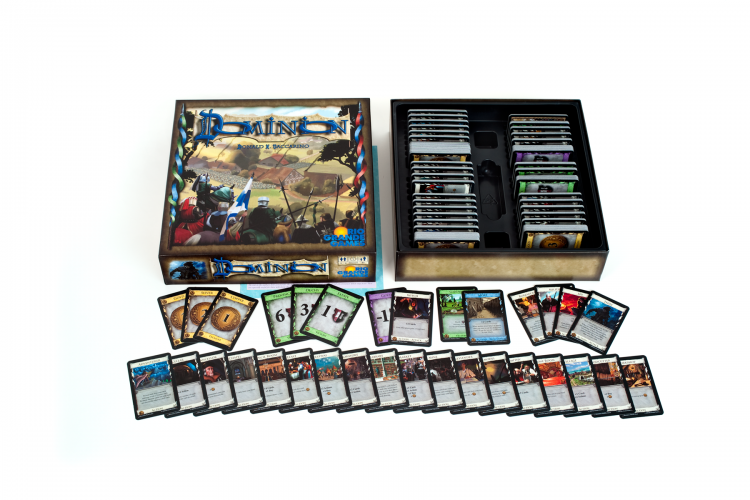
Dominion is a fun and fast game where experienced players can just toss out cards and get in a game without much fuss. Teaching/learning the core mechanics is easy (the game manual offers a few starter combinations) and the rules are simple enough that players only familiar with certain game types can sit down to other expansions and be comfortable playing. Trying to explain this game to newcomers will often have it compared to Magic the Gathering, which is probably about as close as you can get when discussing the universal-but-varying aspect of the game with vaguely similar concepts. Unlike MtG however, the onus is not on the players to bring their own collection of cards and there is no way you can bankrupt yourself chasing specific builds. Each box set is the same collection of cards, with expansions offering different cards on a theme and perhaps a slightly different mechanic to spice things up.
It is worth noting that picking the types of cards you are using also determines the mood and flow of the game. It is entirely possible to have a passive social game without interacting directly with other players. It can be nice to chat idly and play side-by-side in a race to score a winning amount of victory points. On the other side of the coin, there are plenty of opportunities to include attack cards or actions that impact other players and some aspect of gameplay is also building out defenses around that and/or making alliances to stop players that are “the problem.” This more-active game style can ultimately be more rewarding for some players, but as with anything that gets competitive can also be the cause of upset.
This is one of those games that is so open mechanically that an avalanche of expansions is inevitable. For players who want to follow along, there are at least a dozen expansions available that total more than 4,000 total cards. We’re talking about a good amount of shelf real estate. As a collection grows there may be cause to pick up specialized carrying cases, and if you can find a “lazy susan” turntable of a sufficient size it can be very helpful.
Mississippi Queen
Mississippi Queen bumped its way down the river into this bracket via a Play-In game and you can expect Dominion to bump it right back out.
Colt Express
It is an objective fact that train robbery is the coolest crime so it stands to reason that Colt Express should be an incredibly cool game [Ed. Just to reiterate Goonhammer does not endorse doing crimes, even cool ones]. Even setting aside the visual appeal (how many games do you know that have a 3-D punch-board model train as a board?), this is a high-stakes game that will see you fighting not only the other players, but the game itself in your quest to make out like a bandit.
The game plays as a clever programmed movement game with some light press-your-luck elements and some downright mean player interaction. Each round starts with the Schemin’ phase, where the players draw a hand of action cards from their 10-card decks, then take it in turn playing those cards onto a stack in order. You then flip the deck to move to the Stealin’ phase and start drawing cards from it, as each player puts their plans into action to move from car to car, scrap with other players, steal anything that isn’t nailed down, or, if you’re feeling particularly hateful, fire off a shot at your nearest competitor. This is complicated by the symbols on the cards, which can force players to play two cards in a row, play their cards face down so no one else knows what they’re doing, or even reverse the order of play, which in turn reverses the order in which they’ll be resolved.

Most of the actions are pretty straightforward – lateral movement goes one space inside the card, or as far as you want if you’re on the roof. Robbery lets you pick up something off the ground, giving you anywhere from $250 to $500 towards victory. The Marshal action lets you lure the train’s resident lawman to chase after your opponents, tracking them down and chasing them off to the roof of the train with his revolver. And Punching another player lets you shove them to an adjacent car and makes them drop some of their loot so you can find it a better home in your pocket.
But the real star of the show here is the Shoot action. Each player has a six-shooter, which comes loaded with six bullets, represented by six bullet cards in your color. Catch a less-fortunate thief in your sights and you can pop off a shot, giving them one of your bullet cards that they then have to put on top of their action deck. Bullet cards can’t be played and only serve to clog up your target’s deck, cutting down on actions and making it harder for you to move around the car as you take more and more hits. And this isn’t to mention the Marshal in the locomotive, who starts moving back and forth, chasing the bandits across the train and shooting anyone he encounters.
If you think that’s mean, you’re right. But then again, you’re a train robber, so doesn’t that mean it’s a good thing? Well, it is: at the end of the game, the player who’s managed to put the most bullets into other players gets a cool $1,000.00 bonus, potentially pushing them over the top to victory.
So you’ve got your plan, and you’re ready to put it into place. But remember those symbols we were talking about before? Yeah, that plan won’t last. If the train goes through a tunnel at the wrong time, forcing all the players to play their cards face down, you could come out the other side holding your gun in a suitably dramatic pose only to find that you’re staring off into thin air – or worse, down the barrel of the Marshal’s peacekeeper. Any given game of Colt Express is as likely as not to devolve into a comedy of errors as it is to look like a well-planned heist.
Colt Express is, like many Spiel des Jahres winners, a game that has a surprising amount of depth hidden behind the veneer of an easy-to-learn ruleset. You and your friends will move quickly past the “learning the game” stage and likely be firmly in the “I know that they know that I know that they know that I know” stage of mind games by your third or fourth game, and these games don’t take that long. Unlike many Spiel des Jahres winners, though, this game comes with a punch-board model train and a bunch of scenery pieces. And honestly, that should be more common than it is.
Thurn & Taxis
Thurn und Taxis is the 2006 Spiel des Jahres winner designed by the wife and husband team of Karen and Andreas Seyfarth. Mr. Seyfarth was a previous solo SdJ winner for Manhattan, though his most widely-known design is Puerto Rico – a watershed in action selection games that has also been criticized for its eliding of colonialist history.
Thurn and Taxis is named after the titular German private postal service operating for sixty years in the 19th Century. Theme and gameplay are simpatico; players race to quickly and efficiently connect a network of post offices on the map through card drafting, hand management, and set collection.
The board depicts 22 different cities connected by roads and grouped into five different provinces by color, and the 66-card deck contains three each of the 22 cities. On a turn players must draft a city card from the face-up display to their hand, then play a card from their hand that starts or continues a meld in front of them on the table. Melds are sequential but instead of numeric values they correspond to geographically neighboring cities connected by roads on the board. So cards played must trace a connectable route of cities in order – station to station, city to neighboring city. You can add a city card to either end of your active meld (for example adding an A or D to your B-C meld), but if you cannot play a connectable city card to your meld at any point before you can complete a route, the entire route is discarded.
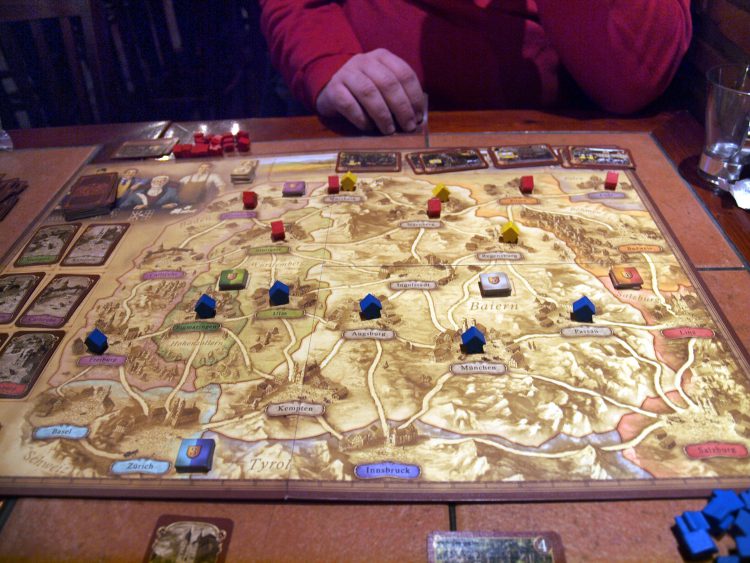
Upon completion of a route players may then place post offices onto the board. Each city can only be “post officed” once per game, and once done that city cannot be used in future melds, so planning is crucial. Completed routes net bonuses depending on route length (five cities long or more), if you connect all cities in one province, or if you can place at least one post office in each province on the board.
Turns are aided by one of four special actions for tactical advantages such as drawing two cards instead of one or add a 2nd card to your route meld. There are also Carriage cards which serve as climbing bonuses for building routes of 3-7 cities in length, and as a timer that triggers the endgame.
Of the forty-odd games in the SdJ field, Thurn und Taxis is fiddlier and drier than most. The rules are simple: take a card, play a card, make sets. But then comes the bookkeeping and multitasking after you finish a card set: keeping track of various ways to score, how and when to place post offices, and minding the several different ways to end the game. There’s no direct interaction on the board; the game is not area control and all players can visit every city. Unlike other games in the bracket, Thurn und Taxis doesn’t reveal much charm after the first play, and its monochromatic presentation with the board and components don’t do it any favors. Thurn und Taxis emits an abstract, dry-as-a-bone first impression, whereas other route planning games in the bracket like Ticket to Ride or Auf Achse or Elfenland elicit far more thematic glee and wonder right out of the box, and a sense of creative accomplishment while you play.
Ticket to Ride is especially notable as a stronger, smoother, far more user-friendly set collection/route builder, which explains its popularity and high seed in our tournament. But Thurn und Taxis came first, provided the shoulders on which Ticket to Ride and other similar games have since stood upon. So Thurn und Taxis deserves mention as a pioneer in Spiel des Jahre history.
Dixit
A French card game introduced in 2008 (it won the Spiel des Jahres two years later), Dixit is a game about nuance and interpretation. The game comes with a deck of 84 beautifully illustrated cards showing a variety of scenes. Players draw a hand of six cards each, then take turns taking on the role of Storyteller. The storyteller chooses a card in her hand and says a sentence or phrase or tells a story that might describe that card’s content, then places it face down on the table. The other players choose cards in their hands that they feel may also be represented by that phrase/story/sentence. The cards are shuffled, then revealed and players place markers on the card they believe is the Storyteller’s.

This is where the nuance comes in – if everyone guesses the Storyteller’s card, the Storyteller scores no points, but each other player does – they’ve been too obvious. On the other hand if no one guesses the Storyteller’s card, they also score zero points and the other players score – they’ve been too vague. Rather, the storyteller’s goal is to have at least one player, but not all of the players guess correctly, in which case they and the correctly guessing players score.
Dixit’s a fun game and easy to grasp mechanically. Because the game does not require reading, it can be something you play with children on the younger side, though anyone younger than six might struggle with it conceptually. It’s cute and easy to play and the expansions just add more cards rather than piling on new mechanics and extra stuff to think about.
Dixit’s challenge in the bracket isn’t that it isn’t a great game – it’s wonderfully simple and beautifully presented – but rather that it isn’t likely to be anyone’s favorite game.
Elfenland
It is a little known fact that Elves pride themselves on a robust and far-reaching public transit system. Young elves have to pass a special test in which they visit as many towns as possible in a short amount of time. They must use the common forms of transport, which are *checks notes* “dragons, unicorns, giant pigs, elfcycles, troll wagons, magic clouds, ferries and rafts”. Pretty standard. Every elf needs to learn how to get on a giant pig after all.
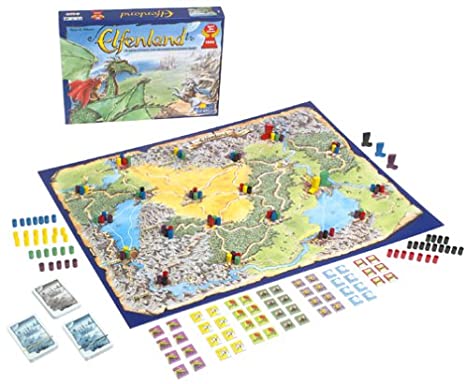
The game itself is played on a map of destinations, interconnected by paths over different terrain, with everyone starting in the main Elf City. The terrain limits which transport can be used – a magic cloud can take you over a mountain but an elfcycle would be useless on water. You and the other players will start each round by drawing out tiles representing the forms of transport, and then putting them on paths on the board. You only have a few tiles, so you will be relying on what others put down to travel far. You also have a hand of eight travel cards. You can travel on a type of transport only if you can discard matching transport cards to pay for it.
As tiles get played to the table, you will adjust your travel plans, and take advantage of opportunities while also routing around problems the other players leave for you. You can even use your once-per-game obstacle tile to really slow the others down! After four rounds, you compare how many towns players have visited and the most travelled player wins! The variant where a player must end the game at their secret destination town is highly recommended!
Hare & Tortoise
Another Play-In Game Winner, Hare & Tortoise hopped in over Focus and is now staring down an industry titan in Carcassonne. Your heart has to go out to these scrappy games.
Carcassonne
There is a common theme among the best of the Spiel de Jahre winners. Many of these games are easy to learn and play in a light casual manner, and then get table-flippingly mean once you’ve got a few games under your belt. Azul’s got hate drafting, Dominion expansions introduce curses, but perhaps no game exemplifies this like Carcassonne. It’s a game where you will lovingingly build a serene landscape of farms, cities, and chapels over the course of 30 minutes or so only to have that asshole friend of yours deliberately cut off your scoring in a move that tanks you and does nothing for them.
All of Carcassonne fits in a large bag. On your turn you’ll reach in and grab your fate. The tile you grab is added to a large communal landscape that everyone builds together. These tiles feature roads, city walls, and various other elements that all contribute to scoring. Scoring is notably the most complex part of Carcassonne and will take a while to wrap your head around, but its also what makes this game so fun.
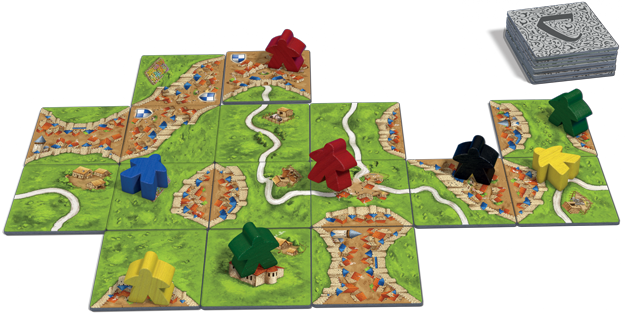
In addition to the tiles everyone has a group of meeples in their color. After placing a tile on the board you can drop your meeple onto one of the elements mentioned above, and all will score differently. Placing your meeple on a road will score you points based on how long the road ultimately becomes. Every element scores a little differently but what is super important is that none of them score until they are complete. For a road that means a city on either end. Chapels need to be surrounded on all sides by tiles, farms sprawl until walled in, and so on. When you score you get to pick your meeple up to be used for future scoring opportunities. However, your meeple is stranded on the board until it does score.
This is where things begin to get spicy. Putting a meeple down claims the element for you; if you’re in a city no one can join you unless you merge two separated cities. However, the sooner you claim a element the longer your meeple may be stuck out there. Your meeples are a precious resource and tension mounts as new scoring avenues open and you can’t claim them since your lazy farmer has been laying in a field since the 2nd turn. Your friends, seeing this, can also play to cut down your scoring.
Carcassonne is a fantastic addition to any collection. It’s easy to play casually, focusing on your avenues and just seeing who wins. It’s also not hard to sink your teeth into it and start to play for keeps. Games like this can age with you and your group, serving to bring people into the hobby and grow with them in whatever direction they want to go. Sometimes you want to casually hang out and drop some tiles, and other times the knives come out. This one is there for you either way.
Bracket Wrap-Up
In the top half of this region, Dominion and its fans start booking their accommodations for the Sweet 16 while Mississippi Queen is still getting its paddle spinning. Dominion created a revolutionary mechanism and continues churning out expansion for those who just can’t get enough card shuffling. In the other match up, Colt Express is going to win. You know how the camera pans to old former players in the middle of a game, listing the years they played for the team? That’s Thurn Und Taxis. Great in its day, and still a game that’s going to give you a good time, but the game has moved on. Also trains. And crimes. And Train Crimes.
Down below we have another interesting match-up between Dixit and Elfenland. Both are cute, approachable, and family friendly. Dixit takes this one however; the art is beautiful and it was the in the vanguard of popular games expanding beyond things like boards and spaces and efficiency. It’s a ‘party game’, but a creative one. It’s also inspired a whole bunch of other great games like Mysterium or When I Dream. Carcassonne is going to roll past Hare & Tortoise and easily dispatch Dixit in the Elite 8, setting up yet another titanic clash. Where Azul vs Catan was a battle of old vs new, Carcassonne and Dominion are more recent classmates.
Bracket Winner – Carcassonne
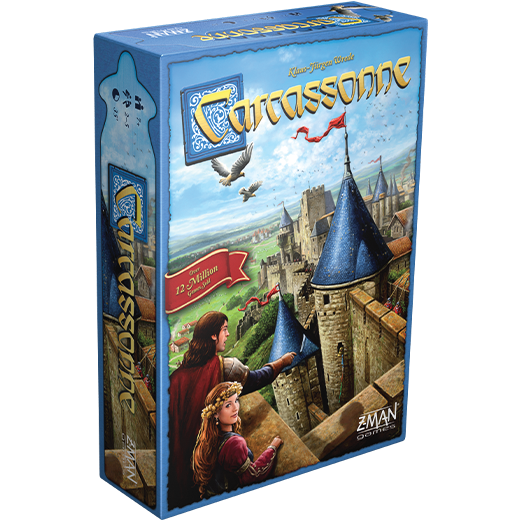
If any of these match-ups is going to be your classic March Madness buzzer-beating double-overtime back and forth battle of two teams that just won’t give up, it’s this one. Both of these games are good and both would be justifiable winners of the whole thing. It’s the kind of matchup that produces a loser only because the rules say there has to be one. Ultimately it comes down to what you value more: pedigree and influence, or table presence and interaction.
It’s impossible to understate the influence Dominion has had on the industry. Deckbuilding has become a common engine that drives games like Star Realms, Aeon’s End, Fort, and more. However, in a way it’s this legacy that tips things in favor of Carcassonne; The games Dominion inspired are more fun than Dominoin. If you put both of these boxes on a table in front of me I’m picking Carcassonne pretty much every time. In a vacuum, the growing sprawl of tiles that juxtaposes against the intense competition that comes out of Carcassonne is just more enjoyable and more compelling than the largely solitaire experience that is Dominion. Sure, expansions add some interaction and curses but if we include expansions then Carcassonne gets to bring a Dragon and an actual functioning catapult to the battle. That’s a recipe for posterizing.


